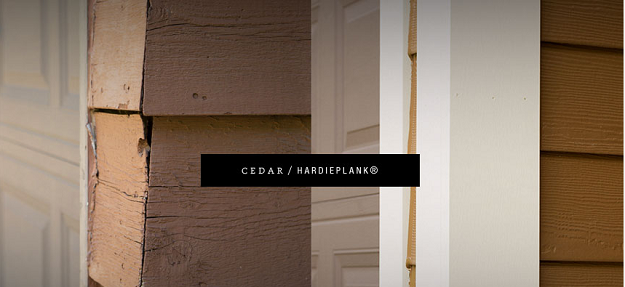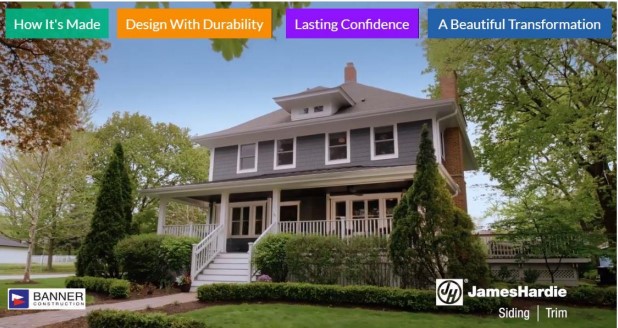
Homeowners around the country are increasingly looking for ways to better the environment. Methods of recycling, products re-use, or even the choice of car driven can all affect the environment. Investing in products that minimize negative impacts on the environment allows homeowners the opportunity to participate in reducing their environmental footprint.
Home renovation projects, like replacing your home’s siding, can be done using sustainable practices and eco-friendly products. Siding options include wood, vinyl, stucco, fiber cement, and other materials. Some are more environmentally friendly than others.
Homeowners should choose sustainable siding products that are durable, low maintenance, non-toxic, recyclable or reusable. Hiring a contractor to install the siding who knows which materials to use and how to properly recycle or reuse them is also important.
What is Sustainable Building?

Sustainable building is the practice of increasing the efficiency with which buildings and their sites use energy, water, and materials. The main focus of sustainable building is to reduce the impact on human health and the environment. To implement these practices, there are certain properties that contractors review in choosing materials and where to build.
Sustainable Building Principles

The goals of sustainable building are to promote conservation and efficient use of a given structure whether it be a home or business property.
Site Potential: The location and landscaping of a building affect energy use. The site of a new or existing building should integrate with sustainable design.
Energy Use: Sustainable building should improve the energy efficiency of the building. This is one way to limit fossil-fuel dependency.
Conserve Water: Water should be used efficiently by reusing or recycling it for on-site use. It is essential to plan a sustainable use of water. Companies can reuse wastewater with the correct treatment systems and collect rainwater.
Environmental Quality: Indoor air quality has a great impact on comfort and productivity. A sustainable home maximizes daylight, has proper ventilation and moisture control.
Materials: The materials used in sustainable building should be recyclable. This is important when choosing materials. Materials that can be re-used or repurposed are the ones to choose. Tiles made from glass bottles or floors made with reused wood from another building are examples of materials being used again.
Maintenance: Sustainable building practices emphasize durable and low-maintenance materials.
7 Factors that Determine Sustainability of Siding

For home builders and remodelers, choosing the right sustainable materials for a project they must consider certain criteria. One main feature of a home is the siding. There are options for siding that include fiber cement, wood, stucco, or vinyl. Of the various siding selections, get answers to the following questions to see how each material measures up.
- What is the siding made of?
A naturally sourced product would be the best choice. Materials made of recycled materials are also a wise option. Other features should include recyclable and non-toxic capabilities. The less environmental the consequences, the better.
- How durable is the material?
A durable siding material will not need to be replaced for a long time. It should have little impact on the environment.
- What kind of maintenance is required?
A durable product will also require little to no maintenance, thus reducing both cost and environmental impact. Replacing or repairing siding can be a negative factor because of the additional materials needed.
- Can the siding material be reused or recycled?
Some siding materials can be recycled or decomposed more easily than others. You can always donate extra home building materials for re-use to charities like Habitat for Humanity. - Will the siding material improve energy efficiency?
Choose a siding material that will improve your home’s energy efficiency. It may cost more in the beginning, but over time you’ll reap the savings on your utility bills. Insulation is a key consideration. Work with a siding material that will allow you to seal and insulate your walls effectively.
- Does the manufacturer source materials locally?
Local materials travel fewer miles to reach their destination. By choosing these products, less fuel is consumed, which results in less air pollution. Responsible sourcing of siding materials has a huge impact on its environmental footprint. Locally-sourced materials also help boost the surrounding area’s economy by creating jobs.
- Does the siding material emit VOCs?
Volatile organic compounds (VOCs) are chemicals used in the manufacturing and maintenance of certain building materials. VOCs may pose health risks if exposed. Health problems include respiratory issues, nausea, dizziness and more.

James Hardie Fiber Cement Siding
Fiber cement siding is the one material that proves to be the best for sustainable building practices. It is a dependable resource in the construction and remodeling of homes.
The most popular provider of fiber cement siding products is James Hardie. Fiber-cement was created by the James Hardie company in the 1980s. It is made up of a combination of renewable materials, including wood, sand, and water. The makeup of fiber cement emits fewer dioxins that come from industrial processes. Dioxins can negatively impact human health.
Sustainability is based on using less, getting the most use out of what is used, and using everything at a pace that can be reused again. The demand for a sustainable environment continues to grow. The James Hardie brand is committed to sustainable practices wherever possible.
As a result, fiber cement has a much smaller environmental footprint than materials like vinyl. The unique qualities of fiber cement are advantageous to conserving resources. Most siding materials will last around 15 or 20 years, with various needs for upkeep and maintenance. Fiber cement siding from the James Hardie company, on the other hand, has a guaranteed warranty of 30 year lasting up to twice as long as other siding materials and requires very little maintenance.
Durability
James Hardie tests its products to ensure they can withstand different weather elements. Hurricane type winds, heavy rains, snow, ice, or extreme heat are no match for James Hardie siding. It is designed to hold up against moisture and prevent rotting. It is even fire-resistant and will not ignite when exposed to a flame.
Fiber cement siding will last much longer than metal, vinyl or wood. This increased longevity saves resources, time, and money. All James Hardie siding products come with a 30-year, non-prorated warranty. The durable composition of fiber cement eliminates the need to re-side homes often, thus reducing the consumption of replacement materials.
Maintenance
Although wood is a natural and renewable material, it requires constant maintenance. If you choose wood siding, you’ll need to re-stain or repaint it every few years, which increases the cost of maintenance.
On the other hand, fiber-cement siding is designed to last a long time, even when exposed to high heat, moisture, UV radiation, and snowstorms. It seldom needs cleaning, but if necessary, you can easily clean it with a soft cloth or sponge, an appropriate brush and a water hose.
James Hardie offers siding in a variety of colors. Their Baked-on ColorPlus® Technology has greater resistance to fading from UV rays, chipping and cracking, meaning an even coverage and vibrant color that will last for years. It also means less maintenance for you.
If you really like the look of wood siding, James Hardie Fiber Cement siding is available in shingle styles like HardiePlank, HardieShingle, and HardiePanel that look just like natural wood, but without all of the maintenance requirements.
Recycling
Fiber cement is made with recycled materials including cellulose fibers, sand, and cement. James Hardie fiber-cement siding recycles the materials in its products – including reusing the water, which is recycled four times throughout the process. James Hardie products are asbestos-free and contain non-toxic components.
Vinyl siding won’t degrade in landfills. It also requires a specialized recycling process. Wood will readily break down in a landfill or composting facility. Fiber-cement siding is so durable that it will be many years before it needs to be recycled.
Sourced Locally
The James Hardie Company has set up a total of nine manufacturing facilities across the country, allowing local vendors and contractors to take advantage of their unique and reliable fiber-cement siding products.
Sustainable building calls for the use of products and materials made locally since they travel fewer miles to get to you. This means less air pollution and fuel consumption. As a result, this reduces the environmental impact and helps boost the regional economy.
Energy Efficiency
With an increasing demand for energy-efficient homes, houses are valued higher when built with sustainable resources. Fiber cement siding will help seal your home due to its ability to resist warping and other external damage. You can keep cool air in during the summer, and warm air in during the winter.
You can also supplement James Hardie fiber cement siding with insulation. The gap between the fiber cement siding and the walls can be filled with foam insulation to help keep your energy costs down.
You can get lots more details about James Hardie Fiber Cement siding by downloading our free guide.
James Hardie Fiber Cement Siding Is Your Green Choice
Banner Construction is committed to sustainable building practices. We’ve partnered with James Hardie to provide the highest quality fiber-cement siding on the market. Our status as an elite preferred contractor with the James Hardie Company allows us to provide the best product with superior workmanship at an affordable price.
For more information about what we can do for your home, contact us today and request a free quote.
